Backcountry Female Hygiene: How to Stay Clean While Camping
Wondering how to stay fresh in the wild? Stay clean while camping and hiking with our female hygiene tips for the backcountry.

At Bearfoot Theory, it’s no secret that we are lovers of the great outdoors. But while we enjoy getting out on the trail, sleeping under the stars, and going on long road trips, we still like to feel fresh and clean. So what’s the secret to staying clean while camping?
As a team made up of all women, we consider ourselves an authority on this issue. So to help out, we’ve compiled some of our favorite female hygiene tips and tricks on how to stay fresh and clean when you are backpacking or camping and miles away from a shower
This post may contain affiliate links.
Here are our best tips for staying clean while camping and enjoying the outdoors.
Staying clean and healthy “down there” while camping
Ok, so you’re going on a multi-day backpacking or camping trip with no showers and maybe even no restrooms. How do you stay clean while camping so you can feel fresh and prevent odors? Here are our tips:
1. Use a pee rag!
Back in 2014, I spent 22 days on the John Muir Trail and I discovered that the most obvious cause of smelly underwear was drip-drying after peeing. Even with the most aggressive shaking, you inevitably end up with a few drops of pee in your undies. At the end of the day, that’s a lot of dried pee that can you leave you feeling smelly and disgusting. Even after rinsing your undies, you’re still left with an odor that you just can’t shake.
The solution to this is simple. Use a pee rag! After peeing, use a bandana, a small quick-dry towel, or an antimicrobial Kula cloth to wipe. In between going to the bathroom, hang your pee rag on the outside of your pack. Then, at the end of the day (or as often as you feel necessary), rinse off the cloth and you’ll be ready to go for the next day. I’ve got step by step instructions for how to use the Kula Cloth if you’re new to using a pee rag.
You can even bring a bit of biodegradable soap to clean it. Just make sure if using soap, you follow Leave No Trace guidelines and wash 200 feet away from a water source.
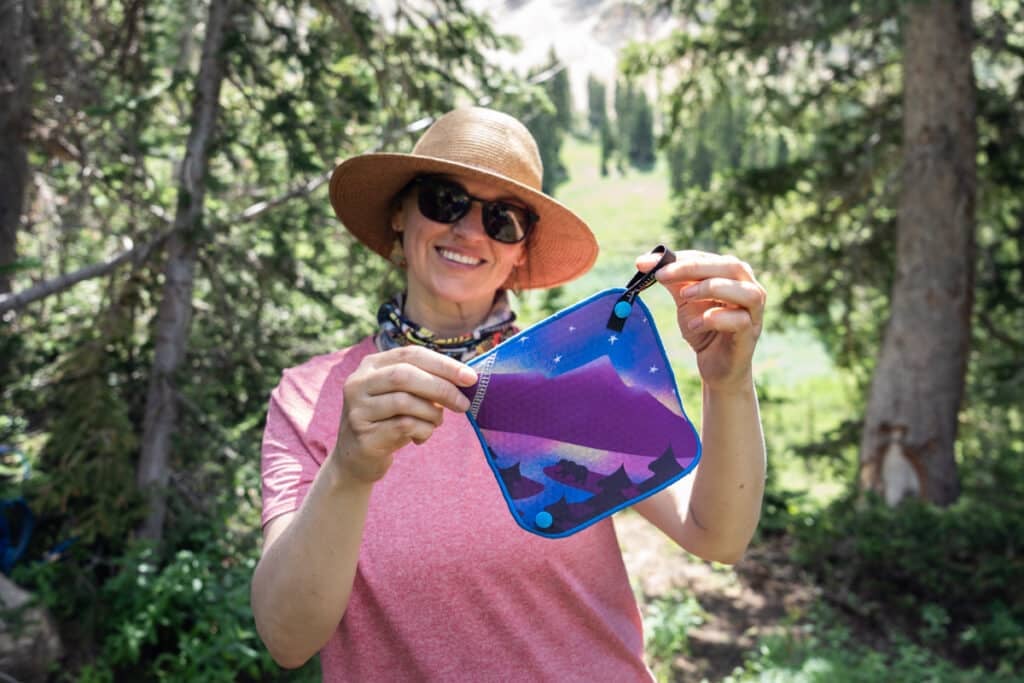
2. Wear moisture-wicking underwear
Cotton underwear is a recipe for a yeast infection. Cotton traps moisture and heat and after a long sweaty day on the trail, those cotton undies can be a breeding ground for yeast. This is especially true if you are prone to yeast infections to begin with and this can lead to a very itchy and uncomfortable trip.
Instead, choose moisture-wicking, quick-dry fabrics that breathe well. Bring an extra pair or two, so you have a dry pair to change into at the end of the day. In between wears, rinse out your undies, and hang them up to dry so you have a fresh pair for the next day.
Check out our favorite moisture-wicking hiking undies for women here.
3. Pack one (or two) wipes per day
Either after going #2 or before going to bed, I use a wet wipe for a complete refresh. The folks at Cora make Individually Wrapped Bamboo Body Cloths that are safe to use all over from your nether regions to your stinky armpits. They are chemical-free and made with plant-based moisturizers & essential oils. Simply wipe as needed and discard the used wipes and wrappers in your ziplock trash baggie.
Each purchase provides proper feminine hygiene supplies for girls in need who might otherwise miss school or be susceptible to disease because of their periods. A worthy cause to support, for sure.
Pro-tip: Even if wipes say they are biodegradable, you need to pack them out with you in your trash.
5. Take a daily probiotic
Whenever I’m traveling or backpacking, I make sure to take a daily probiotic. Probiotics contain strains of good bacteria that support healthy immune, digestive, and urinary function. A major benefit is they help prevent yeast infections too.
When shopping for a probiotic, you’ll want one that doesn’t require refrigeration. This PRO-Women formula by Hyperbiotics is a great probiotic option for camping and traveling and it is specially formulated for women’s health. This probiotic doesn’t go bad outside of the fridge like most probiotics, it has 6 healthy strains of bacteria, and it also contains a cranberry extract to help prevent UTIs. Pop one of these every morning with your breakfast to help keep the yeast and other infections at bay.
4. Don’t hold it
Stopping to pee when you are backpacking may seem like a pain, but holding it can cause much worse problems – like urinary tract infections. So when you feel that urge to go, stop and do your business.

Save this post!
Enter your email & I'll send this post to your inbox! You'll also receive my weekly newsletter full of helpful advice for planning your adventures.
How to camp on your period
Proper female hygiene is crucial when your camping trip coincides with that time of the month. Don’t cancel your trip, just be prepared and remember that it’s nothing to feel stressed out or embarrassed about—even if you’re with a group of guys.
Everyone has their own period preferences so the best plan is to stick with whatever you do at home when you’re on the trail to avoid complications or surprises.
If you use tampons and pads, remember you’ll need to pack everything out, so bring a separate resealable bag (a large zip lock bag works well) and sprinkle some baking soda inside to absorb odor. This bag will also have to go in your bear bag or canister, so keep that in mind as you plan. Bring double the amount of what you think you’ll need because running out to the store isn’t an option!
A menstrual cup is also an option that’s waste-free. These silicone cups can stay in for up to 12 hours without odor or discomfort and are reusable. When you need to empty the menstrual cup, dig a hole in the ground (just like going #2), dump the contents, and use some water to rinse it out. You can also use a little biodegradable soap like Dr. Bronner’s to clean it before reusing it.
Pro-tip: It’s important to have already tried this at home because you won’t want to be dealing with an ill-fitting cup for the first time outside.
Whatever you choose to use, I suggest bringing extra wet wipes if you are camping or backpacking on your period.
How to poop when there’s no bathroom
If you’ve never been backcountry camping before, this will probably be at the forefront of your mind. Lucky for you, we’ve got an entire blog post devoted to the topic of pooping in the woods. Be sure to read it before you head out so you know how to Leave No Trace.
The first step is putting together your poop kit in a big ziplock baggie. Your poop kit should contain:
- A small shovel for digging your cathole so you can Leave No Trace
- Clean toilet paper
- A small ziplock for packing out used toilet paper, tampons, used wet wipes, or other trash.
- Scent-free hand sanitizer
When searching for your ideal #2 spot, you’ll need to dig a cathole that is 6 inches deep and at least 200 feet from a water source. Do your business in the hole, cover it back up, and then pack out all of your used toilet paper.

From a feminine hygiene perspective, wiping shouldn’t be any different than you would at home, except afterward you might choose to use your daily wet wipe for a refresh.
Another option for keeping your bum clean while camping is to pack a travel bidet. These alternatives to wet wipes use a small amount of water and are lightweight and packable.
Keeping your hands clean while camping
Make sure you give your hands a good squirt of hand sanitizer after going to the bathroom, changing your tampon, or cleaning yourself with a wet wipe. Remember, you’ll likely be sharing food and gear with your hiking partners, so do everyone a favor and keep your hands as germ-free as possible for healthy hygiene on the trail.
We also recommend that you give your nails a good trim before starting your backpacking or camping trip so they don’t harbor food and nasty bacteria.
Managing long-hair and tangles
A bun usually leaves my hair in a giant knot at the end of the day. Instead, I’ve found that braiding my hair is the best style for preventing tangles in the backcountry. I generally don’t bring a brush when I backpack, but if you are seriously prone to tangles, a small compact brush isn’t a bad idea to keep the dreadlocks at bay.
For grease, I just cover it up with a hat. If you can’t see it, it’s not there right? Plus a hat helps keep sweat from running into your eyes and prevents too much sun exposure on your face.
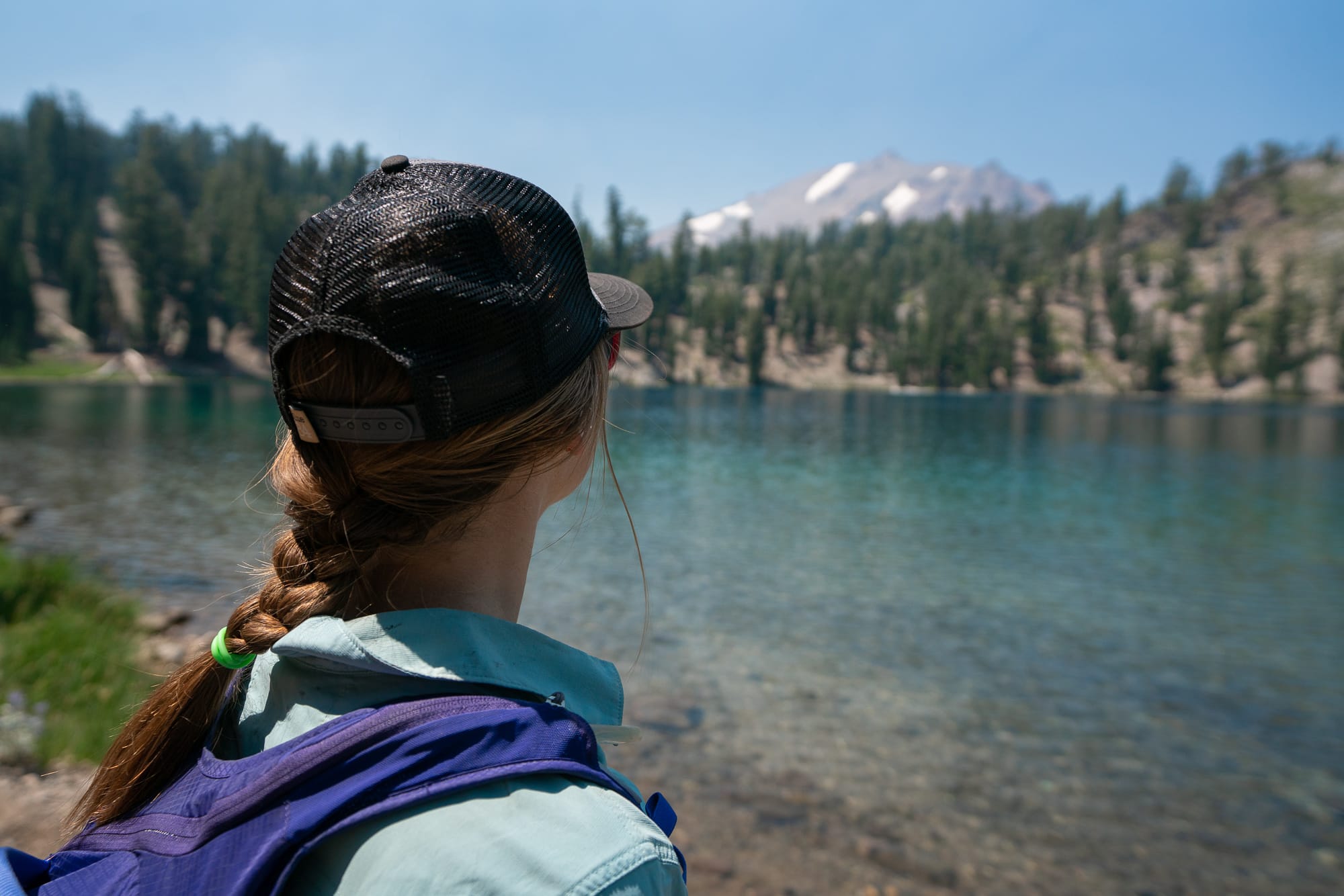
Another great way to keep your hair clean while camping is to use a dry shampoo. Dry shampoos help soak up oils and moisture, preventing your hair from feeling and looking greasy – no water required. The Batiste Dry Shampoo Bare Fragrance is a go-to choice.
Taking care of your feet while camping
Here are some simple tips for taking care of your feet when you are camping and backpacking:
- Allow your feet to dry out at the end of the day. First thing when you get to camp, take off your hiking boots and socks and let your feet air out for a while.
- Set one pair of socks aside as sleeping socks that are always dry and sweat-free. Only wear your sleeping socks at camp or only in your tent if it’s raining.
- When given the opportunity at camp, soak your feet in a cold stream or lake. This will help ease any foot pain, improve circulation, and wash away dirt and grime. Your hiking partner will also appreciate this if you have smelly feet 🙂
- Treat hot spots right away to prevent blisters. For more blister prevention tips, head over to this post.
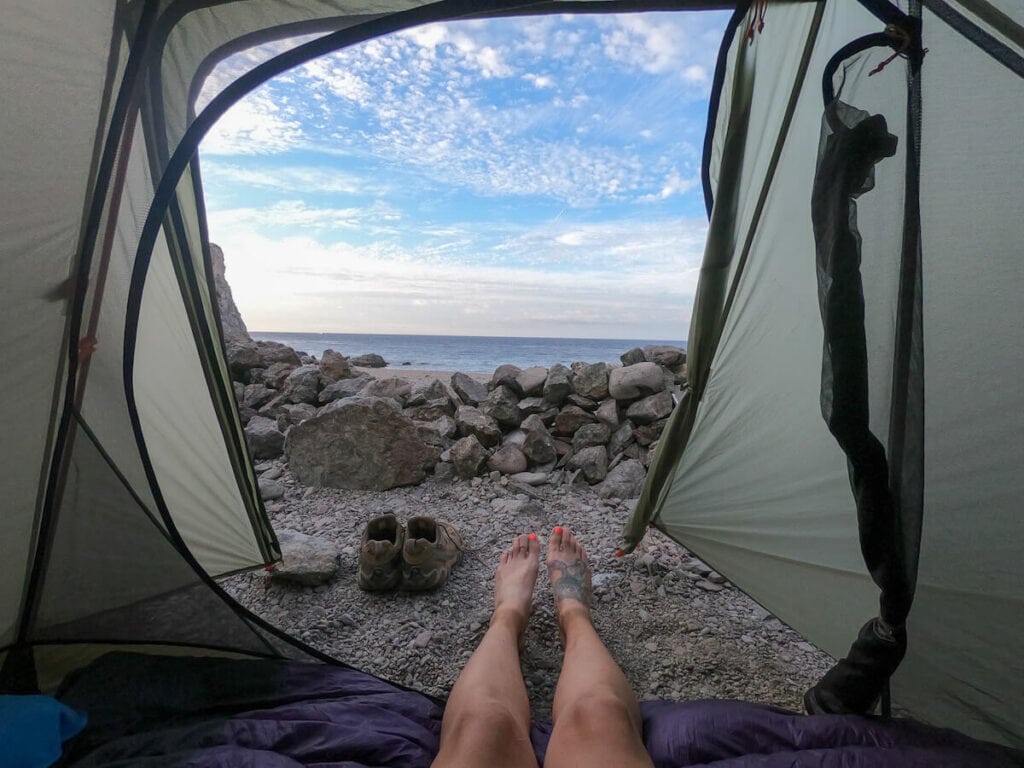
How to shower while camping
If you like the idea of camping, but you don’t love the idea of skipping out on a shower, don’t worry! There are a handful of ways to shower while away from home.
Lakes and rivers
If you’ll be camping or backpacking near a lake or river, the easiest way to shower is to dive in! You can bring a travel washcloth to help clean off the dirt and a quick-drying towel to dry off with. Keep in mind that when the sun goes down the temperatures will drop, so try to get your ‘shower’ in before setting up camp for the night.
Please follow the Leave No Trace principles and avoid using soap, even biodegradable soap, directly in water sources.
Solar shower
Solar showers are a great option if you are car camping or have a basecamp set up for multiple days. The NEMO Helio Shower heats up water under the sun throughout the day or you can fill it directly with hot water. The tank is pressured with a foot pump and the hose is long enough to take a standing shower.
Electric camping shower
If you have access to electricity while camping, the Geyser Systems portable shower has a built-in heating unit that heats water in 15-45 minutes depending on the electricity source. You can use it with any power source (including a vehicle) and thanks to the pump technology, no pressurization is needed. It also comes with a control valve, which allows you to control the water flow rate. You can get up to 15 minutes of usage per 1 gallon of water.
More tips for staying clean while camping
Here are some more tips for staying clean while camping from the ladies at Bearfoot Theory:
“I like to pack light, but I also like to feel fresh and clean, so I often wash clothing by hand when on the road or on the trail. All you need is a little Dr. Bronner’s or other mild soap and some water. Even a quick dunk at the end of the day will rinse the sweat and dirt from your hiking clothes. Just make sure you are keeping the soap out of waterways and give your clothes time to dry or bring one extra set to alternate. Going for a swim after a long day of hiking or camping is a great way to freshen up too!” – Linda, Director
“My favorite products are multi-functional and earth-friendly, of course, so I like to bring a small spray bottle of rosewater and a tube of coconut oil. Rosewater is a gentle astringent that cleanses your skin with a few spritzes, plus it’s refreshing and cooling if you have wind or sunburned skin. Right after, I’ll pat on a few dabs of coconut oil which is hydrating and antimicrobial. It also works well as a makeup remover, a moisturizer, lip balm, and a small amount of SPF in a pinch. I’m also big on using a menstrual cup outdoors.” – Katherine, Contributing Writer
“I swear by Green Goo for anything on the trail. I think wearing high-quality wicking base layers is really important in terms of not developing a rash or irritating your skin with full-day hikes. If I start to get any sort of skin irritation and I can’t shower immediately, I apply Green Goo ointment to the area. I also travel with Goodwipes and DoTerra Peppermint Essential Oil Drops everywhere I go. It’s important to make sure any wipes are safe for our most intimate areas such as these Swipes Lovin All-Natural Intimate Wipes” –Kim, former Community Manager

What are your favorite tips for staying clean while camping and backpacking? Do you have any to add? Let us know in the comments!

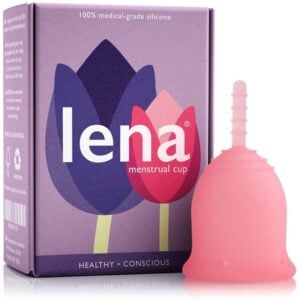


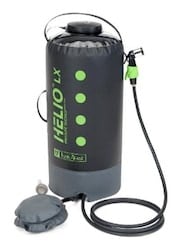
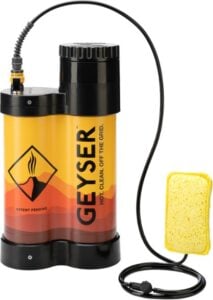

Great tips! Wipes are key! Feels good to get all that sunscreen and grit off at the end of the day 🙂
–Katie @ Katie Wanders
http://www.KatieWanders.com
I’m very confused about the underwear part, I was specially informed by my Gynologolist to only wear cotton underwear because it’s breathable and stay away from other materials. I haven’t had a yeast infection since switching to cotton.
Hi Carissa, thanks for sharing your experience with us! Great to hear that’s been beneficial for you.
Great tips! Additionally, I have become a fan of a small travel bidet. If you have ample access to water (I am in PNW) a travel bidet leaves you super clean and feeling fresh for multi-day/thru hiking trips. It can take a bit more time to prep, but so worth it. It’s also cheap, light weight (with or without water), and less trash (toilet paper/wipes) to carry out. Highly recommend giving it a try! Honestly, it’s like a mini shower.
BioBidet The Palm | Handheld Personal Bidet, Portable, On-the-Go, Travel Bidet with 450ML Water Capacity, Extra Long Pointed Nozzle Spray and Travel Bag Included https://www.amazon.com/dp/B00O92IF6Q/ref=cm_sw_r_cp_apa_i_cjUMCbS73APQ8
Jennifer
I highly recommend bringing along a “backcountry bidet,” also known as a water pistol 🙂
It’s a great lightweight addtion for longer trips.
I’m a massive fan of dry shampoo. Sometimes covering greasy hair with a cap just doesn’t cut it for me. But dry shampoo makes me feel nicer (even if it is just another way of covering up the grease!) A small can doesn’t take up much room in your pack. Better still, you make your own. Way more eco-friendly and lighter to carry: https://wellnessmama.com/5047/dry-shampoo/
I also don’t know how I would live without a mooncup… the best thing EVER (and not just in the backcountry).
This is an old post, but regardless: I, and many others I know, have been given this same story by our gynocologists. And i think it’s good info, if you’re just having a regular old day. But when you’re being active in the outdoors, and sweat is everywhere, the most important factor switches from breathability (which cotton has in spades) to moisture control (which cotton is the aboslute worst at). I’ve found that once cotton underwear gets sweaty, damp from drip-drying, etc., it stays that way. And we all know (for most of us anyway) the most sure-fire way to develop a yeast infection is so sit around in wet undies all day! Obviously this is super specific to each body, but my experience has been that moisture wicking materials (read: not cotton) can be extremely valuable when sweat is a big factor!
Agreed, thanks for making that point. Cotten is usually a good choice, but when it comes to active pursuits like hiking and backpacking, something moisture wicking and quick drying is a better option.
Best tips I’ve ever heard for staying fresh and clean on the road! Thank you so much to everyone who has contributed to this post 🙂
Glad you found them helpful. Thanks for reading!
Great info! We will be hiking on a wildlife preserve in Panama with a group of strangers. I was considering buying a pee funnel. Any experience with one? Just seems more private.
Hi Lida, our team has tried a lot of pee funnels over the years without a lot of success. BFT team member Courtney likes the P Style, it’s a hard plastic that doesn’t have the same learning curve as some of the more “suction” silicone funnels. We’d definitely recommend trying your funnel out in the shower at home first before taking it to the outdoors. Enjoy your trip – that sounds really fun!
I tried the Pstyle on a section hike on the colorado trail this summer & loved it. Hiking with 3 guys, it allowed me to just barely step off the trail, avoid exposure to mosquito bites & poison ivy on my bum, I didn’t have to pull down my pants & it was fun peeing standing up. Paired with a Kula cloth, It was all good. Definitely practice ahead of time!
Glad to hear this method worked well for you too!